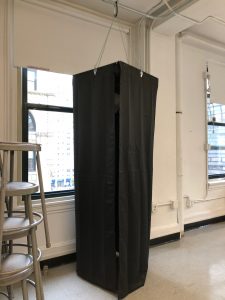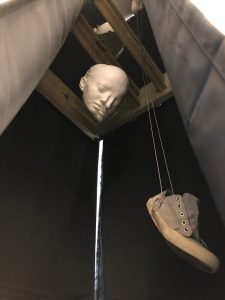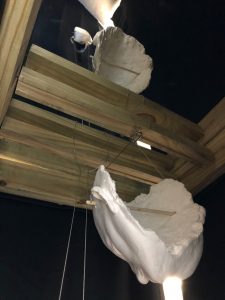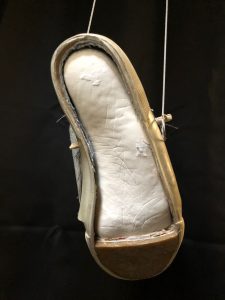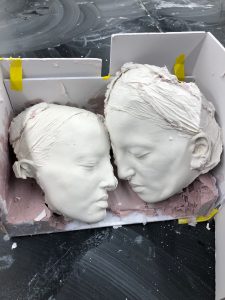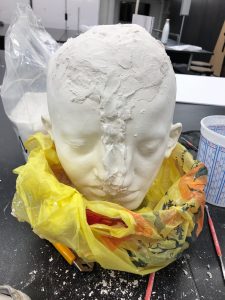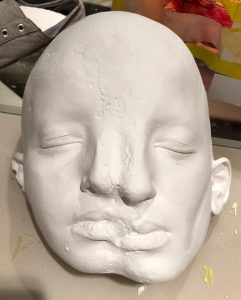materials: plaster, fabric, wood, metal, and glass.
8’x2’x2′
I’ve casted my foot and putted it in a shoe, then i cut out the sole of the shoe to show the bottom of the foot.
i’ve also casted my face, half of it at a time. i tried to get a big portion of my head with my ears, but during de-molding the cast, half of one of the ears broke off. I was able to attach it later with plaster, then carve the ear out.
I’ve attached the two halves with direct plaster and plaster bondage. I first had to tape them together to line them up the way i wanted it, then wetted and textured the inside of the faces, and covered it with plaster bondage. After the plaster bondages hardened and dried, i poured plaster on it, and when that dried i flipped the face over and added plaster in the empty spaces between the two halves.
I then carved and sanded down the extra plaster after it dried.
Reflection
- Describe, using specific adjectives, the qualities and atmosphere of the habitat, or inhabitable space, that
you created for your memory. (I am NOT asking for you to write about your memory here, but about
your project.)
in my piece, a person’s whole body can inhabit the piece; they can go in the curtain the explore the space and the sculptures. The space could either make them feel calm and dreamy or confused and overwhelmed. the whole space is content and surrounded by a black curtain that covers most of the light, which also adds to the mystical feeling of the inside space of the piece.
- What types of inhabitable spaces in the world informed or inspired the design of your project? there isn’t really. i just wanted to show darkness and confusion with my display.
- Write about how you defined an interior and exterior space and curated the experience or movement of your
audience in relation to your piece. Discuss how your project involved or engaged the body of the
audience in the experience of the piece, as opposed to just their sense of sight.
my piece inhabits the whole body of the viewer, they can go into the space, because the work is in the space, so exploration is encouraged from the viewer.
- What did you cast in plaster, and why? i’ve casted my own face and my foot. i’ve casted the face because the memory involves feelings of independence, and i’ve casted my face because in the memory there was a feelings of overwhelmingness that is erased by confusion and an urge for exploration.
- What skill or technique did you use to alter your cast and why? How does your substantively
altered plaster cast communicate aspects of your memory through mass and texture?
i’ve connected to half of my face with direct plaster to show a disoriented feeling. and have attached a real shoe to the foot cast and cut out half of the sole to show make the viewer uncomfortable about the foot postion inside the piece.
- Describe how you chose to display or present your work in relation to the architectural context of the piece. i wanted to show confusion and darkness in my piece and make the viewer experience the feeling of my memory instead of knowing what it is.
- Write any further thoughts about the experience you intended to create for your audience, and discuss the
strengths and weaknesses of your piece.
i think the big space played well in my piece as the viewers thought of very different ideas of what the memory might’ve been about. transporting the piece what the hardest, as it was heavy and big.
